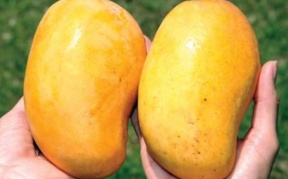From Chiapas to the world! This is the surprising origin of the Ataulfo Mango
News Category: News and Community News
-
The Ataulfo mango became a trend on Twitter this Sunday after user Tomás Cortés (@TCarlos70) posted a message with some facts about this fruit, which has the peculiarity of being originally from Mexico.
“Ataulfo Morales Castillo was a Mexican agronomist who experimented with his mango trees creating grafts until he was able to find the perfect fruit 69 percent pulp, 19 percent peel and 8.5 stone or seed,” wrote the netizen on the social network.
Thanks to him, we have been able to enjoy the Ataulfo Mango since 1963″ added Tomás in the publication, which has received more than 9 thousand likes and has been retweeted 2,500 times.
Ataulfo Morales Castillo fue un ingeniero agrónomo Mexicano que experimentó con sus árboles de mango creando injertos hasta que pudo encontrar el fruto perfecto 69% de pulpa,19% de cáscara y 8.5 de hueso ó semilla.
Gracias a él podemos disfrutar desde 1963 el Mango Ataulfo pic.twitter.com/z5GKeBRnu5— Tomás Cortés (@TCarlos70) July 4, 2021
Although an article by the National Commission for the Knowledge and Use of Biodiversity (Conabio) points out that “the most widely heard version” about the origin of this fruit “refers to five trees that grew naturally in an urban property in Tapachula, Chiapas”.
“This property was purchased by Ataulfo Morales from Manuel Rodriguez in 1948 and the trees were already planted there. It is estimated that the trees were born five years before that transaction, that is, in 1943,” the text indicates.
Later, in 1958, the agronomist Héctor Cano Flores, head of the Sector of the now-extinct Mexican Coffee Institute (IMC), “got to know the cultivar and immediately noticed the exceptional quality of its fruits”.
“He then asked his friend Mr. Morales for permission to initiate the first studies on the trees and to select the seedlings for their asexual propagation. These events coincide with a program that the IMC then put in place to improve coffee growing, which had the objective of substituting coffee for fruit trees in the marginal areas of this crop (low lying areas that are not apt for producing quality coffee).”

Engineer Cano was responsible for the massive propagation of “a mango clone called IMC-m2 Ataulfo. Shortly thereafter, all the vegetative material was transferred from IMC to the National Fruit Commission (Conafrut) to continue with its massive propagation. Years later, the cultivar would be known only as Ataulfo, the name with which the engineer Cano baptized this mango”.
-


Leave a Reply